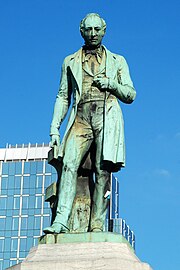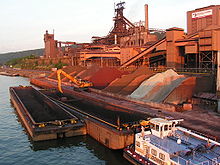Cockerill Sambre
Cockerill-Sambre SA was a Belgian group that was formed after several mergers, mainly concerned with steel production and processing as well as mechanical engineering. The mining company was founded in 1817 by the brothers John Cockerill and James Cockerill, with headquarters in Seraing in the province of Liège on the Meuse and another location in Charleroi on the Sambre .
From the beginning to the independence of Belgium
After John Cockerill had acquired the castle of Seraing in 1817 from William I , the King of the United Kingdom of the Netherlands , and based on the considerable hard coal deposits, the camps of which stretched east-west almost across Belgium, the brothers initially built together Europe's largest iron foundry and machine factory on the Seraing Castle site, which laid the foundation for the development of a widespread company. The investment amounted to 17 million French francs. In addition to the two coal mines and an ore mine, blast furnaces, a steel and rolling mill, a boiler forge and a machine factory were operated and a total of around 2500 people were employed.
After James Cockerill's departure in 1823, who wanted to concentrate his business activities on the Aachen and Stolberg area, King Wilhelm I took over some of his shares and John took over sole management. As a result, Cockerill received financial support from both the Dutch royal family and the Dutch government for the next few years. As part of a major order, the company has now produced, among others, for the Dutch shipbuilder Gerhard Moritz Roentgen , the Dutch Navy and the Rhein-Main-Schifffahrtsgesellschaft. After the Dutch King William I withdrew from the company during the Belgian Revolution , John Cockerill also took over his shares, but further difficulties in the context of the post-revolutionary recession endangered the bloated company.
Liquidation and reorganization
Belgium's independence in 1830 as a result of the Belgian Revolution , which was not accepted by the Kingdom of the United Netherlands , led to domestic and foreign political tensions and to an economic and financial crisis, which among other things also led to the Belgian Bank becoming its main founder John Cockerill counted, suffered from the loss of confidence economically and in 1839 was forced to suspend their payments for the Cockerill works, resulting in liquidation proceedings for the company.
Following this process, the reorganization took place. By selling off large parts of the property, the general director Konrad Gustav Pastor , who had been in office since 1829, succeeded in saving the core of the company - after Cockerill's sudden death in 1840 and taking over the heir Barthold Suermondt in his will - and established the "Societe Anonyme des Etablissements John Cockerill" on the basis of the Serainger facilities to form, "SA Cockerill" for short , which rose again in the following years to a company of world renown. Pastor introduced numerous technical innovations, such as the coke oven , and was one of the first on the mainland to use the Bessemer method .
The Cockerill works played an important role in the economic development of young Belgium, which at the time took second place in Europe after England in terms of industrialization. SA Cockerill supplied the rails for the first continental railway line from Brussels to Mechelen as well as the first steam locomotive manufactured in continental Europe and built under license replica of the locomotives by Robert Stephenson and assembled by Johann Heinrich Ehrhardt , which was baptized with the name Le Belge and started in 1835 named route ran. In the 1920s and 1930s, Cockerill was known for high quality motorcycles . Until 1982 Cockerill also operated a shipyard in the Hoboken district of Antwerp .
Mergers from the 20th century
In 1945, Cockerill merged with its competitor Angleur-Athus. In 1955, Cockerill merged with Ougrée-Marihaye and since then has been known as SA Cockerill-Ougrée. In the same year Ferblatil was also integrated. In 1961 Tolmatil was merged into Cockerill. During the golden 1960s for the coal and steel industry, the Providence ironworks were taken over, which is why the company was renamed Cockerill-Ougrée-Providence. In 1969, Cockerill swallowed the Phenix Works. In 1970 Hope-Longdoz was acquired. The group changed its name again and has been called Cockerill since then. In 1981, Cockerill completed another large-scale merger with Hainaut-Sambre and therefore changed its name again to Cockerill-Sambre SA. The largest Belgian steel group (60 percent share in crude steel production) was created with the majority share of the Belgian state of 80 percent. In a European comparison, the group took sixth place. The steel crisis also left its mark on Cockerill: Between 1960 and 1982, Cockerill closed five coking plants , 16 blast furnaces, seven steelworks and 20 rolling mills . During the same period, Hainaut had shut down three coking plants, ten blast furnaces, seven steelworks and 23 rolling mills. Together with competitors Klöckner-Werke (ten percent) and Hoogovens (five percent), Cockerill founded the Belgian Valfil , in 1979 the most modern and largest wire rod mill in the world at the time .
In 1994, the Cockerill-Sambre Group acquired a stake in Stahlwerke Bremen (since March 2006 Arcelor Bremen ) through its subsidiary Sidmar NV in Gent , which it took over from Klöckner-Werken AG . In 1995, Cockerill-Sambre joined EKO Stahl AG in Eisenhüttenstadt .
In 1998 the company was bought by the French Usinor group, which has been part of the Arcelor group since 2002 . After a spectacular takeover battle in 2006, Arcelor was taken over by the Indo-Dutch competitor Mittal Steel Company NV and has since been part of the world's largest steel group ArcelorMittal , based in Luxembourg.
In 1990, Cockerill-Sambre also took over Ymos Metallwerke Wolf & Becker GmbH & Co from Obertshausen, with all six plants. YMOS (You Must Observe Security) produced keys, locks and accessories for automobile and rail vehicle manufacturers. The company stopped production in 1998/1999 and then filed for bankruptcy.
The name Cockerill lives on to this day - even under changing owners - in Cockerill Maintenance & Ingénierie , which emerged in 1982 from the mechanical and plant engineering division of Cockerill-Sambre.
Web links
- Cockerill share with company description
- Joint entrepreneurial activities by Charles James and John Cockerill with a detailed report on Cockerill-Sambre
- Silke Fengler and Stefan Krebs: Aachen's early industrialization: Belgian-German technology transfer 1815-1860 , lecture manuscript RWTH Aachen, Aachen 2005
- Photos of the Cockerill-Sambre steelworks in Charleroi
- Photos of the Cockerill-Sambre steelworks in Liège
- Night photos of the Cockerill-Sambre coking plant in Seraing
- Night photos of the Cockerill-Sambre smelter in Ougrée
- Early documents and newspaper articles on the Cockerill-Sambre in the 20th century press kit of the ZBW - Leibniz Information Center for Economics .




